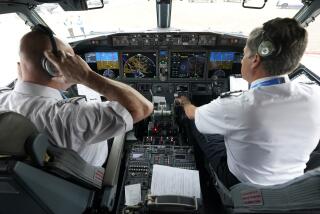Knowledge Eases Fear of Flying : Clinic Boasts 95% Success Rate in Relieving Airline Terror
- Share via
Are you a white-knuckled flier? Do you prop up your courage with too many alcoholic drinks or tranquilizers or postpone trips until you can’t put them off any longer? When turbulence hits, do you find yourself bargaining with the supreme being of your choice?
Perhaps you solve the problem by simply never flying.
If the prospect of taking to the skies fills you with terror, you’re not alone. According to a 1980 Boeing survey, 1 in 6 Americans is too frightened to fly comfortably. With deregulation, crowded skies and security problems, more and more travelers are chewing their nails during takeoff or choosing a grueling session in a car or bus rather than a flight.
I was one of those who refused to fly. For years I passed up vacations, business opportunities, family visits, all because they involved getting into a plane. My fear escalated to the point where I couldn’t even drive past the airport without distress. No matter how many times I heard “flying is safer than driving,” I didn’t believe it for a moment.
95% Success Claimed
Help is on the way.
I found help with the Fear of Flying Clinic, a nonprofit group founded by two dedicated pilots, Jeanne McEllhatten and Fran Grant. This clinic boasts an astonishing 95% success rate.
I found the group to be a tremendous support. Walking into the room and knowing that everyone there had fears similar to mine was a great comfort. Sharing our fears helped diffuse their potency.
Knowledge is good.
To ease our anxiety, we learned relaxation exercises. Since the surest antidote to irrational fear is knowledge, we studied the basics of flight. Contrary to my former belief, it is not magic that holds those big things up. It is physics.
Planes are designed to fly, as boats are made to float.
Many of our meetings took place in the airport, where we became accustomed to the sound of planes taking off and landing. We watched maintenance workers service the aircraft.
(I must confess that I expected to see less-than-full-witted people slapping the things together. Instead, we saw professional mechanics, certified by the Federal Aviation Administration, working carefully and attentively. We found that many flights carry mechanics or their families because of employee discounts; therefore, workers repair the planes as if they were going to ride them--and they are.)
Pilot Answer Questions
Pilots came to our meetings to lecture and answer questions. No concern was too neurotic, and we did our best to challenge their patience.
“What if the pilot were drunk? Went crazy? Bad mood? Took drugs? What if everyone ran to one side of the plane?”
The pilots’ answers were honest, based on fact and reassuring.
While the pilot is responsible for the safety of the flight, the flight attendants are responsible for passenger safety. At the training center, we learned the extensive safety procedures attendants must be able to perform; we even went through a mock emergency evacuation.
Learning about air traffic control, we climbed high into the control tower. We listened to cockpit-ground conversations, while we watched the controllers guide in the massive aircraft.
Enthusiasm for the miracle of flight began to seep into the space where panic once reigned.
Halfway through the sessions, the group took a 15-minute flight. I began it with fingers digging into my neighbor’s hand, but within 10 minutes, something amazing happened. Suddenly flying was not a death-defying act of hocus-pocus, but a mode of transportation like a car, boat or train. Each sound and sensation was just as it had been described in our meetings and just as it should be for safe flight.
I stepped off that plane with a sense that the world had changed; for me, it had.
60,000 Miles Logged
In the past two years, I have logged about 60,000 miles. Occasionally, the old fears pop up. Once I even called the Fear of Flying Clinic from London to help me regain the courage to fly home.
With time, however, these episodes became fewer. I don’t consider them failures, either, because they have taught me a valuable lesson: I might be afraid of a flight, but that does not make the flight dangerous. I can still get on the plane and fly safely to my destination.
When I do find myself a victim of pre-trip crazies or get frightened by a bumpy takeoff, I breathe deeply and remember the marvelous scientific and technological wonder at work lifting the plane into flight.
More to Read
Sign up for The Wild
We’ll help you find the best places to hike, bike and run, as well as the perfect silent spots for meditation and yoga.
You may occasionally receive promotional content from the Los Angeles Times.






